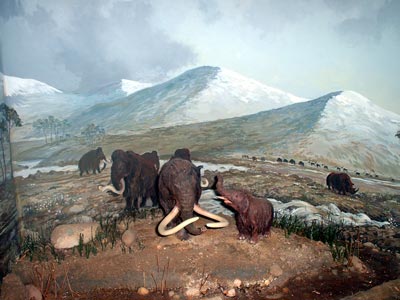Pre-Roman pottery excavated in Kempsey
One sherd (a fragment of pottery) was discovered in the Court House Excavations, in January 1956 a team of archaeologists led by Helen O'Neil. The sherd was from the body of a hand-made vessel, black, made of fairly soft paste with small crushed grit and larger particles and some quartz. The paste can be matched from Early Iron Age sherds from Salmonsbury Camp, Bourton-on-the-Water, Glos. It is similar to ware from Bredon and Sutton Wells.
Reference: "The excavation of the Iron age Camp on Bredon Hill", Glos. Arch. Journal, XCV. "Excavations at Sutton Wells, Herefordshire", Arch. Journal, CX.
A Mammoth Sheds Light on the Stone Age (1992)
A mammoth called Millicent is helping

|
| Diorama of Ice-age Worcestershire in Worcester Art Gallery and Museum. Click here for a larger version. |
Over the past 15 years scholars have argued over whether Britain experienced a long, warm period - a sort of natural global warming - about 160,000 - 180,000 years ago. Until now, geological evidence for this has been scanty, the only clear indication of it coming from animal remains at four sites in the Thames Valley.
For the first time, however, clear zoological and geological evidence has come from a single site: Strensham in Worcestershire. Scientists led by Professor Russell Coope of Birmingham University (now of Royal Holloway University of London), and Clare de Roussignac of Worcestershire County Council have found remains of at least two mammoths, a red deer, 119 species of beetle, 28 species of mollusc and 40 plant species. Most of the mammoth bones belonged to a female who perished, aged about 30, after becoming stuck in a pond. The 10-foot high animal - initially dubbed Marmaduke by scientists - was found after close examination to have been female, and was duly renamed Millicent. She appears to have been born with a malformed lower leg bone, and probably had a marked limp.
Millicent has been donated to Hartlebury Castle Museum by the owners of the site, Associated Land Improvement Holdings, but it will take a few years to prepare her for public display. The latest news (in 1998) is that the British Museum in London want to keep her, they say she is too important to go to Hartlebury.
Research into all the animal and plant species found at Strensham is being funded by Severn-Trent Water; it was during the construction of one of its pumping stations that Millicent came to light. The warm period occurred in the middle of the 100,000-year ice epoch, which preceded the glacial era during which modern humans developed. (Source: The Independent, June 2nd 1992)
The Iron-age History of Bredon Hill
Two iron-age hill camps overlook the Severn valley and Kempsey: the Herefordshire Beacon, which is part of the Malvern Hills; and Bredon Hill. Click here for a map.
"In 1963, a barrow was discovered just outside the parish boundary, near to Well Gate at the top of Bredon Hill. It contained two Bell-beakers, four arrowheads and a scraper. These artefacts belonged to the Beaker people, who settled this area around 1750 B.C.
Abutting the parish boundary, on the summit of Bredon Hill, lie the remains of an Iron Age Camp. It is thought that it was occupied between 200 and 100 B.C. and that probably it was abandoned following a barbarous attack. This conclusion was reached after several skeletons were uncovered during archæological excavations of the site in 1935-7. The presence of the Iron Age people nearer to the village is confirmed by the few pieces of pottery that have been discovered and attributed to that period."
Reference: Wilkes, Nils 1996 A History of Eckington, Worcester, The Trinity Press ISBN 0 9528051 0 3, page 8.
 hits since 9 September 1999.
hits since 9 September 1999.